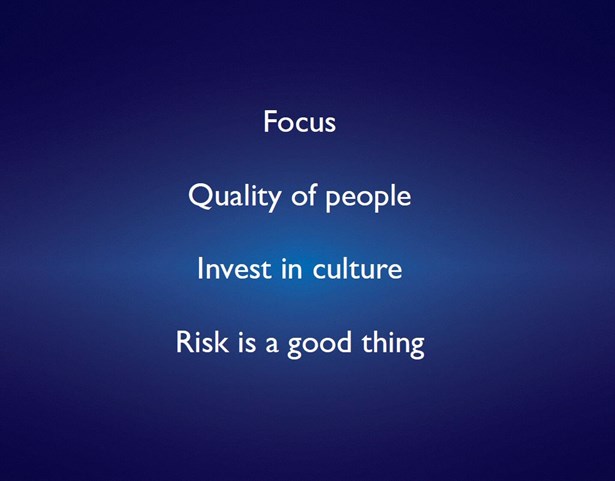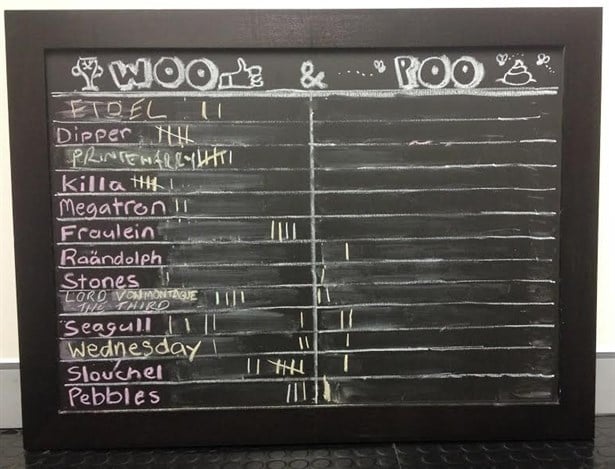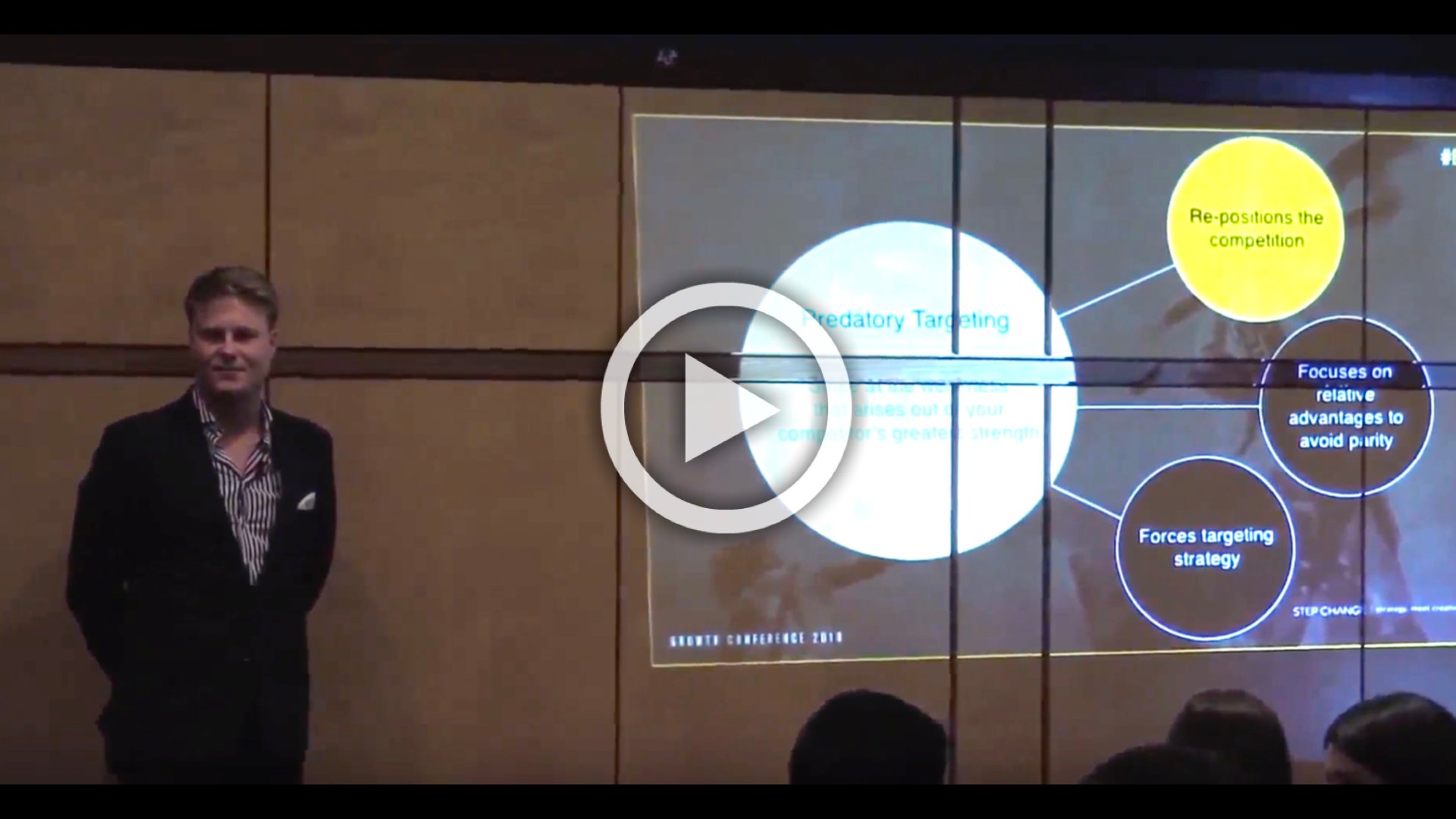This is the seventh in a series of posts featuring Ashton Bishop, the Head of Strategy at Step Change Marketing.
In my last post I talked in more depth about the future growth of Step Change and clarified some of the things I had already discussed in previous posts.
Today I talk about the impact Step Change Marketing has made on our clients and I discuss what it takes to make a successful business.
I was asked the following question:
If you had to give some advice to somebody, a good friend of yours who was about to go into business, what advice would you offer them?
I'd say, "Prepare a keynote slide :-)".

Focus
Focus is the first thing you need if you want to go into business. And it's certainly what I DIDN'T have for a long time.
While trying to start Step Change I was messing around both with colour changing footware and EricThe Circle and it took a lot to get focused on Step Change. I also had a young family, a new wife, and a whole bunch of other things that were clawing for my attention, but somehow I managed to find the focus to make it work.
Quality of people
We've always hired for the quality of person, not the role. Jeff, our General Manager, was amazingly unsuited to be a General Manager at the time but he's amazingly successful at the role now. He's just thirty now and every year we thought if we could just hold him in between the guard rails he would pay off, and now he's paying off in spades.
All of the great talent we have at Step Change we've hired for quality, aspiration, inspiration and the energy they bring to the team. We're just trying to hold them in place long enough to get that payback.
For some of the people in our organisation we've actually changed their role two or three times to keep the talent in the business.
We've had none of the full-time staff churn over the last three years which is amazing in an industry where staff churn rate is up to forty-five percent. We all hold firm together.
Invest in a culture
We were really bad at choosing people through interviews, so we actually went to a three month internship. For staff in the door, we have six-monthly performance reviews and an annual wage review - but as a team, we do goals and aspirations every month.
We sit down and declare what we want for ourselves and how that aligns with the business. We declare what support we need from the business or the team to reach our own personal goals.

We also have a 'woo' and a 'poo' board. Every time you do something good you get a woo and every time you do something not so good you get a poo. It's an instant version of 're-integrative shaming theory' brought to life. Each month the winner gets a couple of gold class movie tickets to go out and it's becomes a fun game that we play together.
We also have an 'um' jar. We're all about powerful communication within the agency and everyone plays the 'um' game. Every time you say 'um', a dollar goes in the jar and once every three months we go out and we celebrate 'um' night.
It's these sorts of things that we have commitments to. We say, let's make our values trackable. Let's have a commitment to powerful communication. So we'll keep on playing another game. We invest very heavily in our culture.
Risk is a good thing
We've taken a lot of risks. When we needed to create new business and we had no new business database we had to build one.
We invented something called 'Stump the Strategist' which is actually probably now more famous than Step Change.

Stump the Strategist will take any questions on marketing communications. We put nine minutes on the clock and then the audience decides whether we're stumped or passed at the end of it.
It's a cross between 'The Gruen Transfer', 'Thank God You're Here', 'Whose Line Is It Anyway' and 'Mr Squiggle'. It is absolute mayhem and madness. The first time we did it we were absolutely bricking ourselves. It was really really scary and there was basically nobody in the audience.
We grew it and grew it. We ran it every three weeks for eight months. Our database went from one hundred to one and a half thousand. We started in Jan and stopped new business August that year. It was a huge risk, it was something the industry hadn't done before, and it paid off.
So, some of the other things we've taken on have been risky too; such as our no invoice policy. No one had done that before, it was scary.
The Virtual Marketing Strategist, building an online platform to automate marketing strategy was scary too. So yeah, we've taken a lot of risks. Some have worked, some haven't worked as well. But we're willing to take the next risk.
The greatest impact we've had on some of our clients
The 'Three Weeks' example I talked about in my last post is the one that's at the top of my mind at the moment but there are lots of little stories of how we have impacted our clients.
One of my favourite things about what we do is that we're strategy first whereas most of the agencies actually make their money on production.
With most marketing agencies, it's like going to a hairdresser. Even if you have a lovely head of hair, a hairdresser will still say you need a haircut, of course.
Now there's a wonderful thing in marketing that's called a one-four-seven ratio that says if it costs a dollar to keep an existing customer, it costs four dollars to cross-sell them into something else, and it costs seven dollars to acquire a new customer.
BRW released a figure about a year and a half ago that said the average cost of acquiring a new customer across categories in Australia is about five hundred and forty-three dollars, when you start to factor in things like staff hours and the new business people's time.
It's absolutely frightening when you look at these figures and what most marketing professionals are telling you to do. Why? Because they're giving away strategy for free and they've got no vested interest in getting you to keep your existing customers or to get more money out of them. Because at Step Change we're strategy first, we're able to start where the best return for the client is.
How an A3 piece of paper made all the difference
One of the things we have is the A3 business card. We like to say (we don't like to say, there's no joy in it) the brochure's dead. People don't read brochures anymore.
People have a conversation in a face to face environment and then they push a brochure your way at the end of a conversation. And you pick it up and you go "oh, that's nice" and then you look at some clip art or some stock photography, then when you get back to your office you put it in the bin.
So we've got an A3 business card that actually doesn't fold nicely and won't fit in bins. And it sits on people's desks and it gets passed around. We pioneered it for ourselves then we started using it for our clients.
A Financial Advisor used the A3 business card and tripled his conversion rate. Once again, a small client, he's a million dollar plus business, not a multi-million dollar or tens of millions of dollar business. When he was telling this story of how he tripled his conversion rate, we were out having a beer. He goes, "Ashton I've gotta tell you, I just never believed what a difference an A3 piece of paper on nice card with a good story could make. It's tripled my conversion rate".
We do a lot about incorporating smart strategies that don't cost a lot in proposals. One of our famous case studies is a twenty-three thousand percent R.O.I. How did we do that?
It was a charity who'd been unsuccessful at getting funding. They put in a proposal and we wrote the proposal for them. It cost five thousand dollars and they got over half a million dollars in funding based on the strength of having the right strategy.
Who's heard of behavioural economics?
For those of you interested in behavioural economics, it's all the buzz at the moment around marketing circles.
There's a wonderful website called www.ted.com which is about technology, entertainment, and design. There's a couple of talks on there that everyone who's interested in communications should watch. One's by Simon Sinnek called 'Start with why'.
Another one's by Rory Sutherland who's a guy I worked with in London. It's called 'Sweat the Small Stuff'.
What it says is that we forget to sweat the small stuff. Numbers based people especially like to think that force and effect correlate. In marketing, it doesn't. There is no correlation between force and effect.
Something as simple as a smart choice checklist in the back of a proposal can change businesses. Just today this business owner wrote to me and went, "We won Freedom. I'm pretty sure the checklist did it". Another lovely little story about impact.
This was the final post of the series. Ashton finishes his presentation by offering the audience the opportunity to read the six books written by Step Change Marketing. The books are toolkits to help solve and frame marketing problems. If you are interested in finding out more about the books contact Step Change Marketing on + 61 2 8028 6405.
Click on the video below to watch Ashton's entire story.














